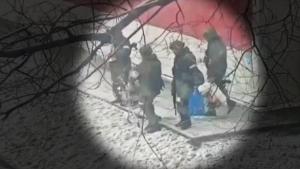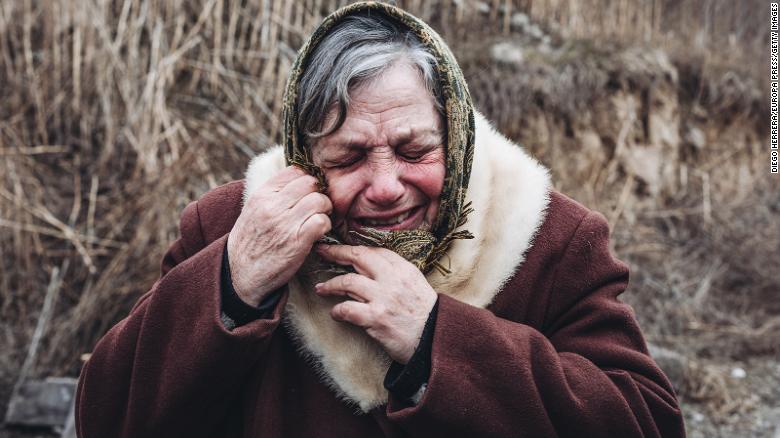 Odessa, Ukraine – Each morning I hope it will be easier to process. But nearly a fortnight into this war, the conflict still seems surreally distant and alarmingly beyond comprehension.
Odessa, Ukraine – Each morning I hope it will be easier to process. But nearly a fortnight into this war, the conflict still seems surreally distant and alarmingly beyond comprehension.
Try to ask yourself “how is this happening?” and you lurch out over an abyss so profound it is beyond the reach of your senses.
And even if Putin does think he can get his old empire back, how do these 13 days of savagery make that happen?
The slow and clumsy Russian campaign for the south has been the most baffling. It is clear what Moscow wants: To cut off Ukraine’s access to the Black Sea.
What is hard to fathom is whether the Kremlin’s plan to get it has collapsed, and Russian troops are just throwing rockets and tanks at anything they can, or whether this sort of total war against Ukrainians was always the plan.

The city of Kherson was the first to “fall,” but that was not really what happened.
As we watched the fight for the strategic bridge to the city’s east, I tried to reassure locals that the Russian army had no interest in their homes and would drive on by, eager to get to Odessa, further west.
But I was wrong — again — about the extent of Moscow’s ambitions.
(I have, since the first intelligence warnings about a full Russian invasion of Ukraine, felt the idea was so preposterous it must be born of an intelligence failure, not a historic intelligence success).
Russian troops did enter the city of Kherson, where they were reported to have looted shops, arrested men, and shot in the air at protestors. The residents here call them “Orcs” — the lumbering monsters from the Lord of the Rings.
It is a marvel that Moscow was either so convinced civil disobedience would not be a problem or decided that they simply did not need a plan to deal with it. The Kremlin’s attempt to film Russian aid trucks handing out the solution to the problem its invasion created was greeted with local scorn and profanity. The protests go on.
The port of Mykolaiv is next on the Russian route to Odessa, Ukraine’s third-largest city. The Russian “plan” for Mykolaiv is even more disconcertingly opaque. Shelling is a big part of it; over a week they have hit civilian targets there multiple times.
Last weekend, when their missiles blew out the windows and roofs of civilian buildings as a consequence of a strike on Ukrainian armor in the city center, that may have been by accident.
But this weekend — even at the most generous assessment — it was through carelessness so extreme it was surely criminal. They seem to just be lobbing rockets, into the city’s suburbs, CNN seeing three instances where apparent cluster munitions had landed in residential areas. NATO on Friday said it had seen the use of cluster bombs by Russia in Ukraine.
And again and again on Mykolaiv’s outskirts, the Russians keep coming. The attacks seem to falter every time. At one roundabout, we saw a Russian Tigr armored vehicle on fire on Saturday, Ukrainian troops lying in defensive prone positions around it.
Some 24 hours later, at the same spot, Ukrainian troops had found time to graffiti the unexploded rockets that landed around them with anti-Putin abuse, and the Russians had been pushed further back down the road.
Farmers were clambering over an abandoned T90 tank, trying to get it started and quite quickly diagnosing it had a steering problem.
That, and the tank having been trapped the ruins of a collapsed bridge, perhaps explains why it had been abandoned.
But this was not a rare occasion. On Sunday, the regional governor Vitali Kim posted a video of himself inside another captured Russian Tigr vehicle.
Another video showed what seemed to be a significant Russian artillery unit in flames, destroyed or abandoned. The person filming joked that the scarred machines’ remains were what “is what’s left of our ‘brothers,’ the ones that came to ‘save us'” — a reference to Moscow’s gibberish assertion that it is engaged in a special operation to demilitarize and “de-Nazify” Ukrainians subjugated under a vile regime.
The Kremlin’s propaganda — for years something so concentrated and cynical that it found its way into the information ecosystem, and even turned some souls — is dismissed with the same disregard with which it was authored. It really is just nonsense, and it is refreshing to see most sensible media not even give it oxygen.
Odessa is the prize on the coast. On Monday morning as the city was blasted with horizontal snow, the sirens rang out, enflaming residents’ fears of a Russian amphibious landing.
Those last three words sound ridiculous here, in a city with hipster dumpling stores hidden in stairwells, and a series of road signs that tell any new Russian arrivals to “f**k off” (straight ahead), “also to f**k off” (left) and to “f**k off back to Russia” (right).
The entire Russian project in Ukraine is the stuff of a malarial nightmare. Putin’s plan still doesn’t make sense. Did the Kremlin genuinely think that Ukraine would collapse in a week, its citizens welcoming them in?
If so, then why has the strategy swung so rapidly toward a form of collective punishment once it became clear they were not welcome at all? Was there no plan for something in between appreciation and annihilation?
Why are the Russian units we see trying again and again to hit the same targets, often using very similar approaches? Why are so many abandoning their vehicles and accepting capture? And why is the Russian air force, for years flaunted as Putin’s new hi-tech toy, proving so very ineffective?
There is a temptation to seek rational answers to these questions.
The reason we are in this dark place is the failure of the rational to dominate in the Kremlin.
We just do not know how far Putin — who over the course of two weeks has tried to encircle a capital city, placed his strategic nuclear defenses on a higher level of alert, used cluster munitions and attacked a nuclear power plant — will go.
Again and again, the war fails to make sense. It seems to be outside the reaches of what I thought our shared reality was. We can only hope it does not stay that way.
As reported by CNN
